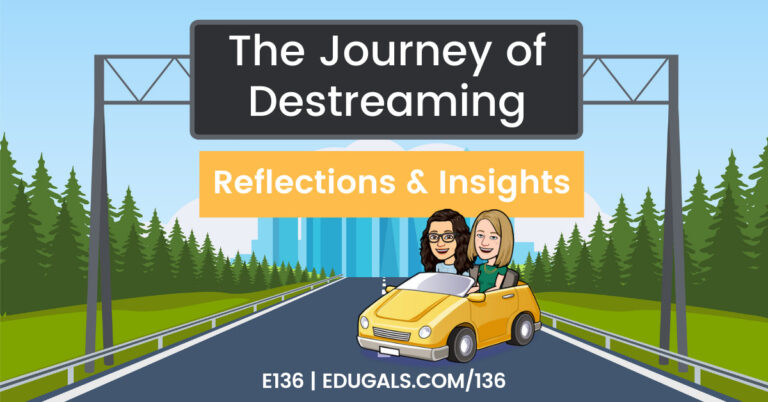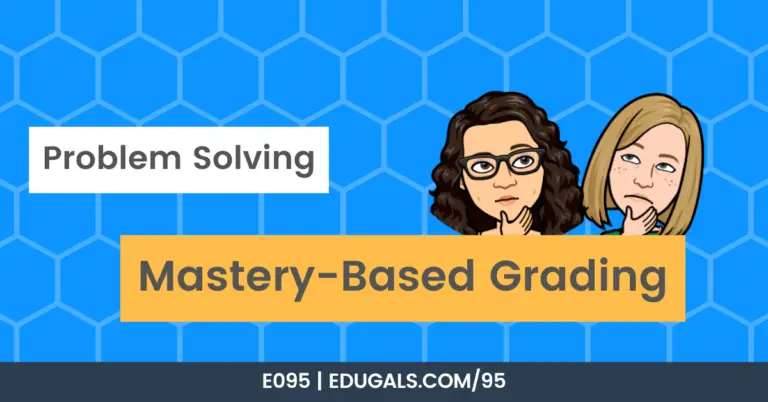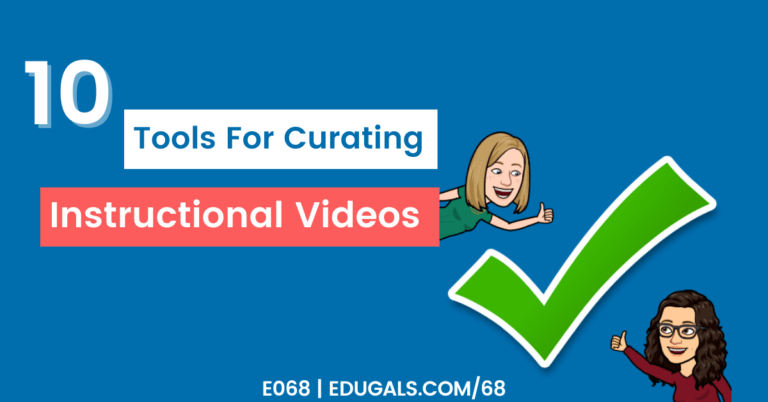[podcast_subscribe id=”7428″]
In this episode, we are talking about some of our reflections on virtual schools, and what it could look like moving forward. We will share how we think it could work, and how it could be planned effectively.
If you like what you hear, share this episode with a colleague or friend, and make sure you subscribe so that you don’t miss out on any new content! If you are able, consider supporting the show by buying us a coffee!
We would love to hear from you – leave a comment here, OR check out our FLIPGRID!
Show Notes
This week, we thought we would do things a little bit different. We have decided to share whatever is on our mind, versus focusing on a specific tool. It’s essentially the episode where Katie and Rachel went off the rails!
It evolved to become an episode that focused on the current rumours in Ontario education about the possibility that virtual schools will remain beyond the pandemic.
There has been a lot of push back, but it’s worth talking about some of the potential benefits for students with respect to virtual schools.
Gut reaction: it needs to implemented properly and purposefully, with a budget to reflect that it is a priority. We also need to weigh the pros and cons, particularly surrounding the loss of socialization that would result, particularly in programs that require more interaction.
The current virtual schools model is not reaching all kids. There is too much required synchronous time, which means there isn’t enough time for students to process and work asynchronously, and it also isn’t flexible enough.
The question: How do you design virtual schools in such a way that they build in flexibility and allow students to have options? It shouldn’t work within the traditional box that we consider school. We need to reimagine what education can look like virtually.

There also needs to be staff that WANT to innovate and teach online. Hiring needs to be purposeful, and teacher development needs to happen. Teachers need to be willing to open their classroom door, invite others in, and find ways to improve their virtual teaching practice. There is so much value in observing one another, and seeing best practices that you could then use in your own class.
That being said, it’s a fine balance, particularly because imposter syndrome is quite common among educators. It needs to be low stakes, and a conversation, not an official teaching evaluation process.
Virtual schools cannot be a dumping ground for teachers that are avoiding the classroom, or who do not have the desire to teach virtually. There needs to be an actual, effective plan to make sure that it is properly implemented and staffed if we hope to make virtual schools work.
Staffing is such a vital piece of the puzzle.
Capping attendance is also one way to ensure that there are enough student supports in place, as well as purposeful staffing. It’s better to start small, build capacity, and then go from there. But with that, there’s the question of “who” – who will be able to attend virtual schools? How will that be determined? Will there be a lottery system? A registration system based on date/time of submission?
With capping, we then come across the question of what programming will be offered? Will ESL (English as a Second Language) be offered? If so, will international students be allowed to attend virtual schools from their home country? Will newcomers that move to our province and/or Board have the option to join virtual schools when they arrive? What courses will they offer? There are so many bigger equity questions that come to play when talking about the possibility of a virtual school.
Some alternative schooling formats that we’ve come across are the following:
- Build a credit system
- This is a module system. The are 4 modules per credit, with an inquiry project at the end based on one of the modules that interested the student.
- At the end, the student will then get a credit based on the expectations met.
- Could something like this be built for virtual schools? There are neat benefits to this type of option, as it has the potential to hit different pathway options. This is currently being done as a student success model in WRDSB.
- Section schools
- Students can earn partial credits in this model. When combined with build-a-credit, this could help students be quite successful.
- UN Sustainable Development Goals
- Instead of traditional courses, you could offer streams based on these UN Goals. Students could gain partial credits based on the curriculum areas that are encompassed within that goal, as they are learning that material.
- This gives flexibility to learn material based on when it is needed, and to then build on that knowledge. For example, you could focus on electricity and cover curriculum expectations from Grade 9, 10, and 11 science courses. Or, you could choose a goal, and earn partial credits for geography, science, etc., depending on what is relevant to that particular goal.
- Modern Classroom Project & PBL
- In a webinar from MCP, they spoke about Project-Based Learning (PBL) within the Modern Classroom.
- During that webinar, they introduced an LMS called Headrush, which supports PBL, partial credits and mastery-based grading. It creates task boards, where kids can add in evidence for the things they are working on. It also tracks mastery-based grading, and when students have earned partial credits.
Skill-based and/or a mastery-based approach will definitely work for virtual schools. It’s a great way for students to demonstrate the acquisition of skills and learning of materials.
Modern Classrooms Project has a free course, as well as a virtual mentorship, where you are paired with a mentor and will receive feedback. It goes over a few months, and they also offer a summer program as well.
We are both contemplating our fates for this summer! While we are tired, we are torn! Should Rachel teach summer school? Should Katie work at the Welcome Centre? So many questions!
A tool that has come up that could be quite helpful is OBS Studio (Open Broadcaster Software). It is a software program that can be used to record videos, stream, or use as a virtual camera. It is available for MacOS, Windows and Linux. It allows you to set up a scene, and then use that as your camera in a Google Meet or Zoom. You can also flip back and forth between different scenes while teaching. You can do some really neat things with green screens too.
Steven Fotheringham, created a blog post on OBS Studio, showcasing all of the neat things that he is doing with this software. Rachel also created a video submission for the MCP using OBP – check it out here!
This could be a neat tool for virtual teachers and/or students! It would be neat to have studio booths for teachers with green screens, technology, equipment and sit/stand desks in a place dedicated for virtual staff.
That brings us to the idea of a community space for virtual teachers. Having a common building for virtual staff and students allows that community building, and also the hands-on learning activities that tend to be lacking in e-learning and/or virtual courses. We feel that it would still be important to have a physical space for students and staff to gather and interact – a sense of belonging and community is vital for student success.
Virtual schools would also allow for far more flexibility in scheduling. Teenage brains don’t do so well with early starts, so virtual schools could allow for a later start in the morning.

Many here in Ontario are not so happy about the government announcements regarding the possibility of virtual learning being here to stay. The fear right now is that the government is going to force any e-learning courses out of Boards, and towards a private company without certified teachers, or synchronous opportunities to support our learners. In that sense, we also share that fear, but we still feel like there’s a potential for virtual learning to be quite successful if it is allowed to remain with school boards.
One last idea or thought for virtual schools is the idea of combined/co-taught courses and team teaching. It’s a great way to share ideas, and help support our colleagues and students. Teachers can share their passions with students, and it allows staff and students to interact with more people in the school community.
Do you have some ideas or suggestions for how virtual schools can work effectively once this pandemic is over? We’d love to hear from you! Leave us a message on our flipgrid, or leave a comment!






One Comment
Comments are closed.